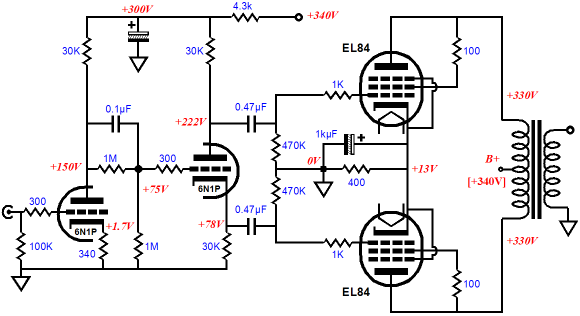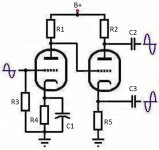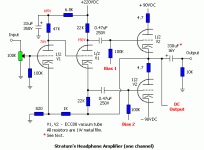Hi !
Can someone please help me filling in the blanks ?
Looking for unity gain, or close to.
Tube = ECC81 or '82 or '83
B+ = 180V
R1 =
R2 =
R3 =
R4 =
R5 =
C1 =
C2 =
C3 =
I want to use this as a stand alone single ended-to-balanced line driver
Cheers,
Empee
Can someone please help me filling in the blanks ?
Looking for unity gain, or close to.
Tube = ECC81 or '82 or '83
B+ = 180V
R1 =
R2 =
R3 =
R4 =
R5 =
C1 =
C2 =
C3 =
I want to use this as a stand alone single ended-to-balanced line driver
Cheers,
Empee
Attachments
I want to use this as a stand alone single ended-to-balanced line driver
The O/P impedance of that style of circuitry is likely to be too high. FWIW, I believe that line drivers should be "comfortable" working into the IHF "standard" 10 KOhm load.
You want SE I/P, some gain, and "balanced" O/P. A differential gain block, AKA long tailed pair (LTP), will do the job for you. Snip out the small signal circuitry from the attached "El Cheapo" schematic. Ground the non-inverting grid. Buffer the LTP with ZVN0545A source followers DC coupled to the 12AT7/ECC81 anodes.
Attachments
Last edited:
Hi !
thank you both for your replies.
The device i want to use it for is an old DIY amplifier i got.
it's home was a recording studio.
It only has symetrical inputs, being driven out of a balanced mixing desk.
thank you both for your replies.
The device i want to use it for is an old DIY amplifier i got.
it's home was a recording studio.
It only has symetrical inputs, being driven out of a balanced mixing desk.
Two problems: 180V is way too low for an ECC81/82/83. ECC83 is not very suitable for a cathodyne- ECC82 is better but has questionable linearity. ECC81 would be OK. Your best choice here is an ECC88, and you still would want a higher B+.
If you can manage 250V, then for ECC88, 15k plate and resistor loads are optimum. Shoot for a grid voltage of ~80V- that will probably mean step network coupling from the voltage amp, but will get you 90V across the ECC88 which is adequate for good linearity. I'd recommend you check out the ImPasse article in AudioXpress and my recent article on cathodynes in "Linear Audio" where I show the effects of loading (the ECC88 as a cathodyne performs superbly even with a tough load). It would also be very worthwhile to work through the math in Morgan Jones's description of the Bevois Valley amplifier in his book "Valve Amplifiers."
If you can manage 250V, then for ECC88, 15k plate and resistor loads are optimum. Shoot for a grid voltage of ~80V- that will probably mean step network coupling from the voltage amp, but will get you 90V across the ECC88 which is adequate for good linearity. I'd recommend you check out the ImPasse article in AudioXpress and my recent article on cathodynes in "Linear Audio" where I show the effects of loading (the ECC88 as a cathodyne performs superbly even with a tough load). It would also be very worthwhile to work through the math in Morgan Jones's description of the Bevois Valley amplifier in his book "Valve Amplifiers."
ECC88 is definitely the way to go if you stick to B9a basing. I'm working on a similar project, but I'm using 6111 subminiature triodes, with cathode follower outputs, B+ 165 or so. Mine is mainly going to be for moderate to high impedance loads/experimenting with push-pull output stage experiments.
Excellent !
Thanks SY !!
I just ordered the Linear Audio vol. "0".
and I also happen to have a few E88CC's around 🙂
I'm sure i can get the voltage up, but maybe it will mean i have
to make a PSU instead of using what i already got. No problem.
Meanwhile, i found this on HeadWize. I uses a ECC88 as a cathodyne !
but forgive me for this noob-question:
what is exactly a "gain of 25" ?
how does that relate to, say, 2 volts p-p on the input ?
Cheers !
empee
Thanks SY !!
I just ordered the Linear Audio vol. "0".
and I also happen to have a few E88CC's around 🙂
I'm sure i can get the voltage up, but maybe it will mean i have
to make a PSU instead of using what i already got. No problem.
Meanwhile, i found this on HeadWize. I uses a ECC88 as a cathodyne !
but forgive me for this noob-question:
what is exactly a "gain of 25" ?
how does that relate to, say, 2 volts p-p on the input ?
Cheers !
empee
Attachments

I recently built this little EL84 PP amp...the front end is a nice cathodyne style. It sounds really good. Courtesy of Tubecad.com
Last edited:
but forgive me for this noob-question:
what is exactly a "gain of 25" ?
how does that relate to, say, 2 volts p-p on the input ?
A gain of 25 means that whatever is input is multiplied by 25 at the output. So 2V p-p would then be amplified to 50V p-p on the output. With 70V on the first stage plate of the circuit you showed, the distortion would be pretty high. Feedback to the cathode of the first stage can ameliorate that- with the values shown, the gain is closer to 2.
Yes, the ECC88 is great for this application. The only issue for 100% reliability is the max filament-to-cathode voltage. Unless one has got very old types the max rating for ECC83 and 82 is 180V while for ECC81 it is 90V. For the ECC88 this is particularly low at 50V.
So it is a good idea to use 1 ECC88 for the input (one section for each channel) and another ECC88 for phase splitting. Each valve with its own 6.3V secondary lifted to the same voltage of that of the cathode (or slightly higher).
45
So it is a good idea to use 1 ECC88 for the input (one section for each channel) and another ECC88 for phase splitting. Each valve with its own 6.3V secondary lifted to the same voltage of that of the cathode (or slightly higher).
45
Which is ironic, because it's a cascode RF amp tube. It does have enough perveance to be useful even at fairly low voltages though (get maybe 5mA out of it).
Tim
Tim
With 180V plate supply for the cascode you can be safe by referring the filament to 45V which is half way between the two cathodes. One has to rely on the quality of the tube....
You can do the same also in this case if you are going to have 80-90V plate voltage for the input tube however I had some insulation issues in the past (not only with the ECC88 but also with other ECC's with safer margins) and I always prefer to have two separate filament supplies, unless I already have the power transformer and no possibility to do this. The overall VA rating is the same and I just spend a little bit more on the additional winding.
This thing is even more critical when you deal with SRPP's and mu-Followers.
45
You can do the same also in this case if you are going to have 80-90V plate voltage for the input tube however I had some insulation issues in the past (not only with the ECC88 but also with other ECC's with safer margins) and I always prefer to have two separate filament supplies, unless I already have the power transformer and no possibility to do this. The overall VA rating is the same and I just spend a little bit more on the additional winding.
This thing is even more critical when you deal with SRPP's and mu-Followers.
45
Last edited:
Thank you all for your replies,
and thanks for pointing out the need for the elavated potential on the heater.
I have much more questions to ask, but I think I'll wait till I have read the Linear Audio article.... I have the feeling I won't have any questions after that 🙂
thank you all, again !
Cheers,
Empee
and thanks for pointing out the need for the elavated potential on the heater.
I have much more questions to ask, but I think I'll wait till I have read the Linear Audio article.... I have the feeling I won't have any questions after that 🙂
thank you all, again !
Cheers,
Empee
- Status
- Not open for further replies.
- Home
- Amplifiers
- Tubes / Valves
- Cathodyne: Can someone please help me fill in the blanks ?


